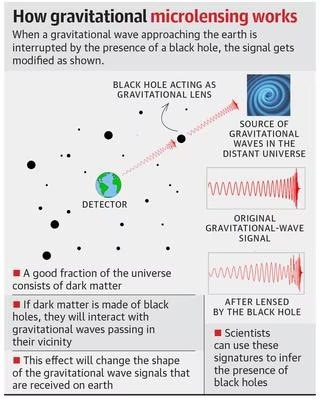Ahmedabad
(Head Office)Address : 506, 3rd EYE THREE (III), Opp. Induben Khakhrawala, Girish Cold Drink Cross Road, CG Road, Navrangpura, Ahmedabad, 380009.
Mobile : 8469231587 / 9586028957
Telephone : 079-40098991
E-mail: dics.upsc@gmail.com

Dark Matters
News: A recent hypothesis says that dark matter comprises a large number of compact objects such as primordial black holes.
What are Dark Matters?
• Astronomical observations suggest that a significant part of the universe is made up of dark matter which interacts with the rest of the universe only through the gravitational pull.
• Many large lab experiments have tried to detect elementary particles that could be candidates for dark matter.However, such dark matter particles have not been detected until now.
• Several astronomical observations suggest that all galaxies are embedded in a “halo” of dark matter.
• The “visible” galaxy is like a disc embedded in a dark matter halo that is much larger in size.
Latest updations:
• When the universe was very young, hot and dense – soon after the Big Bang, it must have had quantum fluctuations of its density.
• This, in turn, would have caused some regions to become extremely dense, and therefore, to collapse under their own gravity to form the primordial black holes.
• While we have no conclusive evidence of spotting these objects, some of the binary black hole mergers detected by the LIGO gravitational wave detectors might be primordial black holes.The question is open there is good reason to believe that primordial black holes did form in the young universe.
Gravitational Lensing
• The paper explores what happens when such objects get in the way of gravitational waves traveling towards the Earth from the distance.It invokes a phenomenon called gravitational lensing that is used regularly in astronomy.When light travels through space and passes near a massive or compact body – a star, a galaxy or a black hole, for example, the intense gravity of that body may attract the light towards it.
• This causes bending it from its rectilinear (straight line) path.
• This phenomenon is known as gravitational lensing and was first observed by Arthur Eddington in 1919.
• Massive objects like galaxies can bend light significantly, producing multiple images, this is called strong lensing.Lighter objects like stars or black holes bend light less, and this is called micro-lensing.
• A similar lensing can happen to gravitational waves travelling towards the Earth, and this would leave signatures in the detected gravitational waves.This can be used to detect the presence, or the existence, of primordial black holes.
Assessing dark matter
• Until now, individual black holes have not marked out these signatures on gravitational waves detected by the LIGO-VIRGO detectors.However, if all of the dark matter is made of primordial black holes, they should have produced detectable signatures on the gravitational wave signals.The researchers use the nonobservation of the lensing signatures to assess what fraction of the dark matter could be made of black holes.

Address : 506, 3rd EYE THREE (III), Opp. Induben Khakhrawala, Girish Cold Drink Cross Road, CG Road, Navrangpura, Ahmedabad, 380009.
Mobile : 8469231587 / 9586028957
Telephone : 079-40098991
E-mail: dics.upsc@gmail.com
Address: A-306, The Landmark, Urjanagar-1, Opp. Spicy Street, Kudasan – Por Road, Kudasan, Gandhinagar – 382421
Mobile : 9723832444 / 9723932444
E-mail: dics.gnagar@gmail.com
Address: 2nd Floor, 9 Shivali Society, L&T Circle, opp. Ratri Bazar, Karelibaugh, Vadodara, 390018
Mobile : 9725692037 / 9725692054
E-mail: dics.vadodara@gmail.com
Address: 403, Raj Victoria, Opp. Pal Walkway, Near Galaxy Circle, Pal, Surat-394510
Mobile : 8401031583 / 8401031587
E-mail: dics.surat@gmail.com
Address: 303,305 K 158 Complex Above Magson, Sindhubhavan Road Ahmedabad-380059
Mobile : 9974751177 / 8469231587
E-mail: dicssbr@gmail.com
Address: 57/17, 2nd Floor, Old Rajinder Nagar Market, Bada Bazaar Marg, Delhi-60
Mobile : 9104830862 / 9104830865
E-mail: dics.newdelhi@gmail.com